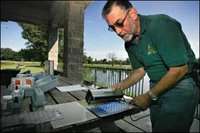Lower Shoal Creek Watershed Group.2
The Neosho Daily News, Wednesday July 26, 2006 and The Joplin Globe, Tuesday July 25, 2006, reported on organizational progress that the Lower Shoal Creek watershed group is making. As reported previously in this Blog, the group first met on June 13, 2006. The initiative is being coordinated by The Environmental Task Force of Newton and Jasper Counties. A steering committee is being formed to "study, analyze and remediate environmental pollution problems on the lower Shoal Creek watershed." The spokesman for the group is Newton County Presiding Commissioner, Jerry Carter.
The groups agreed on three primary goals:
(1) Determining contaminants in area waterways,
(2) Finding out the sources of those contaminants, and
(3) Determining what can be done about them.
The area being designated by the group as the Lower Shoal Creek Watershed includes: from its headwaters in Barry County (MO) to its confluence with Spring River west of the Missouri-Kansas line near Riverton, KS. Mr Carter said that the people to be served are the residents who live in the watershed, including those who get drinking water from the creek or use it recreationally, and any others who would be affected by management of its watershed. These would include agricultural interests and businesses affected by Shoal Creek.
The following are some of the topics covered during the meeting:
Funding of the organization - Harry Rogers, former Carthage mayor and executive director of the Harry S Truman Coordinating Council, will report on funding efforts as well as measures to obtain a non-profit 501(c)(3) status for the group; Volunteers, getting enough people for measures such as stream teams, water quality monitoring, serving on the watershed group and the like; Educational outreach; Collaborating university resources, such as the Ozark Environmental Water Resource Institute; Canoeists and litter's impact on waterways; Drinking water supplies for people and livestock; Enforcement measures; Sustainability of watershed improvements, and having the time to pull all of these projects together.
The group also shared their concerns and cares about area waterways and with the watershed association. Among these: Getting representation from across the state line in Kansas, as the watershed extends as far west as Empire Lake at Riverton; Getting more representation from Shoal Creek landowners on the watershed group; Getting more representation from area cities and industries; Water quality and groundwater issues, including falling water tables and increases in fecal coliform colonies and the presence of heavy metals in area waterways, a leftover of the area's mining past; Getting representation from the Neosho National Fish Hatchery at watershed sessions; Getting representation from Granby / East Newton County.

